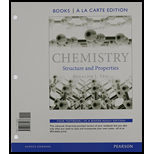
Interpretation:
Carbon shows unique properties it form very large no. of molecule. Catenation is the linkage of atoms of the same element into long chain this property dominate in carbon atom due to which carbon forms very larger no. of compounds. Carbon is capable of forming many allotropes due to its unique property.
Carbon has several allotropes
Diamond graphite fullerenes Nanotubes Nanoribbons.
Concept introduction:
Fullerenes nanotubes and Nano ribbons are allotropes of carbon. Their basic structures are different.
To determine: the structure of fullerene, Nano tubes and Nano ribbons.
Want to see the full answer?
Check out a sample textbook solution
Chapter 13 Solutions
Chemistry: Structure and Properties, Books a la Carte Edition & Modified MasteringChemistry with Pearson eText -- ValuePack Access Card -- for Chemistry: Structure and Properties Package
- High-density polyethylene (HDPE) is opaque while low-density polyethylene (LDPE) is transparent. Briefly explain this phenomenon in terms of structure.arrow_forwardUse an example to show how branching and cross linking can affect the physical behavior of a polymer.arrow_forwardDescribe biopolymer and synthetic polymer. Give examples to support your answer Briefly discuss the classification of polymers. Why polymers are widely used in our daily life?arrow_forward
- Explain how many chain isomers are possible for C4H10. Define their structure.arrow_forwardWhat is the definition of gelatinization and gelation of starch? Describe the two processes and list out the key molecule involved.arrow_forwardWhat are the characteristics of Biodegradable Polymers ? Explain importance of this as well ?arrow_forward
- What are the 4 basic steps in determining a protein structure using x-ray crystallography?arrow_forwardWhat are the different polymers used in the preparations of cosmetics?arrow_forward(a) What is a monomer? (b) Which of these molecules canbe used as a monomer: ethanol, ethene (also called ethylene),methane?arrow_forward
- What is the difference between crystal and polycrystalline materialarrow_forwardExplain why sugar C12H22O11 is a bad conductor of electricity while table salt NaCl is a good of electricity?arrow_forwardA student adds bromine solution to a test tube containing an isomer of C3H6. After shaking the sample and exposing it to UV light, the student observes that the colour of the bromine solution changes from orange to clear. Provide a hypothesis for what happened in the test tube. What do you believe to be the structure of the original isomer, and what was the final product, if a reaction occurred?arrow_forward
 Introductory Chemistry: An Active Learning Approa...ChemistryISBN:9781305079250Author:Mark S. Cracolice, Ed PetersPublisher:Cengage Learning
Introductory Chemistry: An Active Learning Approa...ChemistryISBN:9781305079250Author:Mark S. Cracolice, Ed PetersPublisher:Cengage Learning
